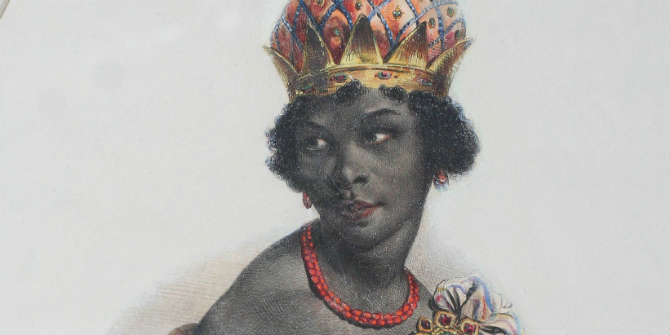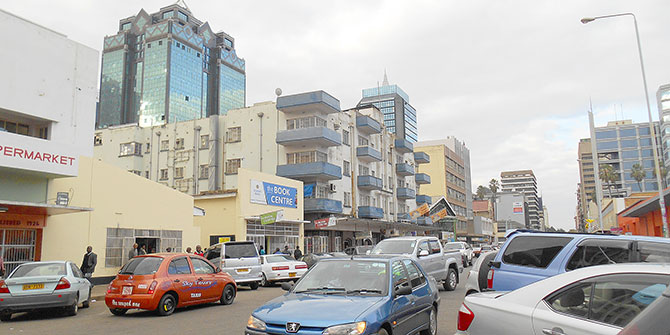Moroccan garment design and consumption have experienced major shifts in recent history, transforming from a traditional craft-based enterprise to a thriving fashion industry. Influenced by western fashion, dress has become commoditized and has expanded from tailoring to designer labels. This book presents the first detailed ethnographic study of Moroccan fashion. Hailey Maxwell found the book interesting but hoped for more vibrant language and a more generous selection of images.
M. Angela Jansen’s latest book presents an overview of the history of Moroccan fashion from modernity to the contemporary; paying particular attention to fashion as a sociological marker and an important way in which we can observe the construction of cultural identity. This book presents an important contribution to both fashion history and anthropology; convincingly and with sincerity and the author treats dress as the materialisation of broad, interrelated cultural phenomena, historical and economic processes and societal changes within a non-European nation rather than artefacts of alien traditions and cultures which resist transformation and development or items of purely technical interest.
Usurping the Euro-centric understanding of modernity, Jansen gives an interesting and comprehensive account of Morocco’s historical, cultural, social, religious and political development as the country transitioned into a unique form of modernity, paying close attention to the important nuanced and particular position of Morocco as at the cusp of both Europe and the Arab world. These meticulous and specific details paint a comprehensive picture of Morocco as an idiosyncratic nation with a paradoxical character; a nation both in continual flux, diversity and transformation while at the same time deeply rooted in tradition and conservatism. As a hybrid construction, Moroccan identity is both a particular, unique type of Arabo-Muslim identity and an identity consistently influenced by the European world; Jansen explores the nation’s complicated relationship with and mediation between each of these cultural poles. While acknowledging the important and changing position of Islam within construction of the national, Jansen makes a series of important distinctions between religious and national dress and the frequent osmosis of fashion between these two institutions. She focuses her study on urban areas; Casablanca, Fez and Marrakesh, busy cities in which change and dynamism are more emphatic and which are more obvious sites of commercial, industrial and cultural activity.
Jansen is concerned with the production, consumption and dissemination of Moroccan fashion and explores the development of these three areas over the course of a century; focusing on the political, social, religious and economic changes which shift the way in which fashion operates and is received.
The first generation of fashion designers, working in the 1960s-80s including Zhor Sebti, Tamy Tazi and Naima Bennis, emerged from a class of newly educationally and socially empowered women who kickstarted the Moroccan fashion revolution. These designers sold their designs locally, at most,exporte on a small scale. The second generation of Moroccan designers, ‘Generation Caftan’ were far more numerous than their few predecessors paved their way. This generation grew and flourished with the opening of fashion schools in the country and the expansion of technique, more negotiation and dialogue with the European market which in turn led to the commodification of Moroccan fashion in Europe. The growth of the press; television and lifestyle and fashion magazines greatly expanded the market for consumption in this era lead to the growth of commercial Moroccan brands and fashion houses.

Media plays an important role in disseminating lifestyle ideals and fashion trends to the hungry market; Jansen attributes the press having had influence in three crucial areas; modernisation, democratisation and commodification. She mentions that the first generation of fashion magazines were especially concerned with female emancipation. This is an extremely interesting chapter which lends the subject of the book particular importance; the expansion of the Moroccan fashion industry and the pervasive issues around gender equality in the country run somewhat in parallel, with fashion paving the way for women’s economic independence. It is clear that the existential shift in how women viewed themselves and looked towards European (specifically French) models of female emancipation, (which were of course very interesting around this period) and the kinds of emancipation the growing fashion industry allowed are intertwined. In the contemporary world, the internet as a mode of communication and consumption has made fashion, both Moroccan and European, more accessible while the emergence of the fashion blog has promoted and expanded engagement with fashion across a broader social strata.
While it is very clear the author has researched her area meticulously, Jansen’s dry, clinical language doesn’t quite express the vibrancy of Morocco or Moroccan fashion or the passion for the subject she clearly possesses. The somewhat cold, detached tone and colourless language makes it somewhat difficult for the reader to engage with the reality of the dynamic, beautiful country and its changing fashions, a weakness which could perhaps be offset if a more generous selection of images were featured in the volume.
Overall, the book uses the growth of the fashion industry in order to emphasise the way in which Moroccan identity negotiates and interchanges between two worlds and how these realities interact with each other through the rise of modernity into the arena of global capitalism. Fashion as an example both illustrates the development of commerce and the transformation of personal identity across the last century.
Moroccan Fashion: Design, Culture and Tradition. M. Angela Jansen. Bloomsbury. November 2014.
This review was first published on the LSE Review of Books.
Hailey Maxwell has just finished her Masters in Art, Politics, Transgression at the University of Glasgow. She hopes to continue as a research student in the future. She lives in Glasgow.
The views expressed in this post are those of the authors and in no way reflect those of the Africa at LSE blog or the London School of Economics and Political Science.






